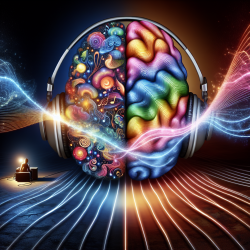Introduction
In the realm of therapeutic interventions, acoustic stimuli, particularly music, have emerged as a powerful tool in enhancing physiological and psychological well-being. Recent research, such as the study titled "Treatments and regulatory mechanisms of acoustic stimuli on mood disorders and neurological diseases," underscores the profound impact of music therapy on mood disorders and neurological diseases. This blog explores the potential of music therapy in clinical settings, especially for practitioners working with children, to improve outcomes through evidence-based strategies.
The Power of Music Therapy
Music therapy has been shown to offer significant benefits in various health contexts, from stabilizing vital signs in preterm infants to enhancing cognitive functions in adults with neurological disorders. The research highlights several key areas where music therapy can be particularly effective:
- Neurological Disorders: Music therapy shows promise in treating conditions like Alzheimer's and Parkinson's disease by modulating neurotransmitter levels and enhancing neural circuitry.
- Mood Disorders: Acoustic stimuli can regulate mood by influencing neurotransmitters such as dopamine and serotonin, offering a non-invasive treatment option for depression and anxiety.
- Developmental Benefits: For children, music therapy can aid in brain development, improving cognitive functions and emotional regulation.
Mechanisms of Action
The therapeutic effects of music are mediated through various biological mechanisms:
- Neurotransmitter Regulation: Music influences the balance of neurotransmitters like dopamine, oxytocin, and cortisol, which play crucial roles in mood regulation and stress response.
- Gene Expression: Exposure to music can alter gene expression, promoting brain development and enhancing cognitive flexibility.
- Neural Circuitry: Music engages neural circuits related to reward and empathy, fostering emotional connections and enhancing social interactions.
Implementing Music Therapy in Practice
For practitioners, integrating music therapy into treatment plans can be a transformative approach. Here are some practical steps to consider:
- Customized Playlists: Develop playlists tailored to individual needs, focusing on specific therapeutic goals such as relaxation or cognitive enhancement.
- Collaborative Efforts: Work with music therapists and neuroscientists to design interventions that are evidence-based and patient-centered.
- Continuous Research: Stay informed about the latest research in music therapy to refine and optimize treatment strategies.
Conclusion
Acoustic stimuli, particularly music, hold immense potential in treating mood and neurological disorders. As a safe, cost-effective, and non-invasive intervention, music therapy offers a promising avenue for enhancing health outcomes. Practitioners are encouraged to explore and implement these strategies to harness the full potential of music in therapeutic settings.
To read the original research paper, please follow this link: Treatments and regulatory mechanisms of acoustic stimuli on mood disorders and neurological diseases.










